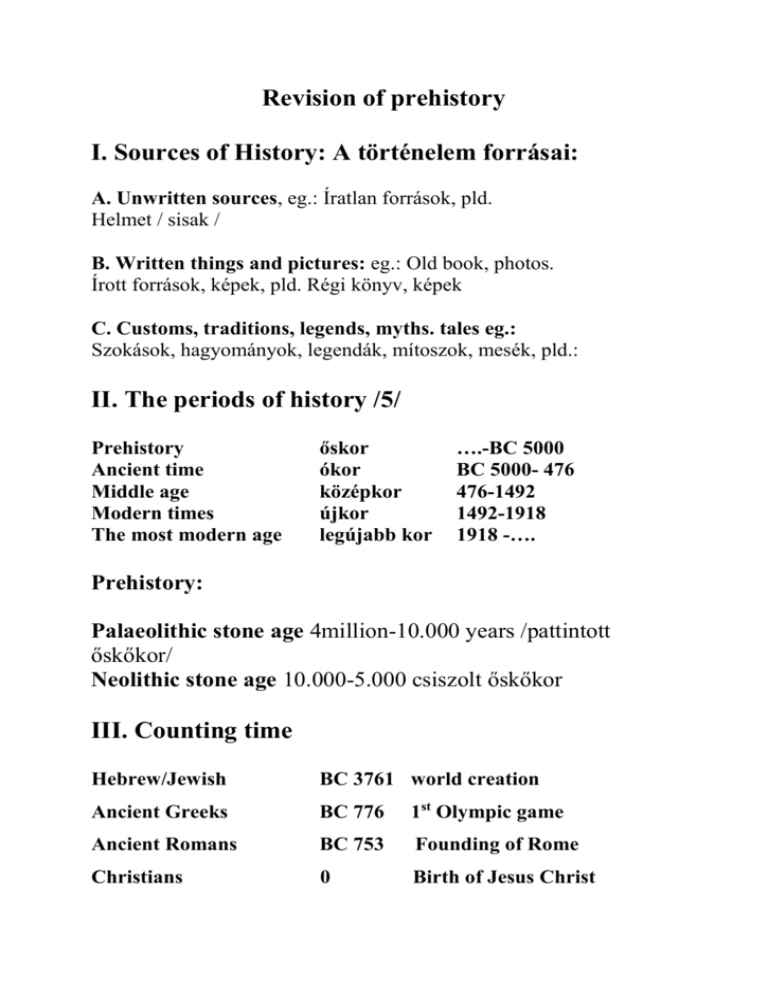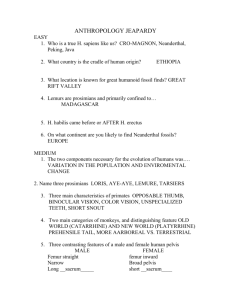Revision of prehistory
advertisement

Revision of prehistory I. Sources of History: A történelem forrásai: A. Unwritten sources, eg.: Íratlan források, pld. Helmet / sisak / B. Written things and pictures: eg.: Old book, photos. Írott források, képek, pld. Régi könyv, képek C. Customs, traditions, legends, myths. tales eg.: Szokások, hagyományok, legendák, mítoszok, mesék, pld.: II. The periods of history /5/ Prehistory Ancient time Middle age Modern times The most modern age őskor ókor középkor újkor legújabb kor ….-BC 5000 BC 5000- 476 476-1492 1492-1918 1918 -…. Prehistory: Palaeolithic stone age 4million-10.000 years /pattintott őskőkor/ Neolithic stone age 10.000-5.000 csiszolt őskőkor III. Counting time Hebrew/Jewish BC 3761 world creation Ancient Greeks BC 776 1st Olympic game Ancient Romans BC 753 Founding of Rome Christians 0 Birth of Jesus Christ Muslims 622 Mohamed prophet’s run to Medina IV. How do archaeologists work? 1. Satellite imagery /műholdas felvétel/ 2. Aerial survey / légifelvétel / 3. Field survey /földi kutatás/ 4. Surface survey / földfelszín kutatása / 5. rough excavation / durva ásatás/ 6. Accurate excavation / Finom ásatás/ 7. Photo, video 8. Analysis / Elemzés/ 9. Reconstruction V. Development of human beings 1. Australopithecus majomember They lived roughly 4 - 2.75 million years ago. There is, however, strong evidence that they used sticks and bones to help them dig and defend themselves. Our most ancient ancestor is Australopithecus afarensis. " Lucy". Males and females show a considerable difference in size, varying from 1 - 1.7 m in height and from 25 - 50 kg in weight. This bipedal ancestor had a brain capacity that 380 - 450 cc. Hominids: emberszabásúak 1. Homo habilis,SKILLED which means ‘person with abilities.' It is believed that Homo habilis lived until about 1.5 million years ago. It is believed that Homo habilis were the first hominids to create and use tools. 2. Homo erectus inhabited Africa, Asia and Europe some 1.6 million years ago, and remained active in these areas until around 250,000 years ago. Fossils of Homo erectus have been found in forests, plains and grasslands. Historians believe that Homo erectus began as gatherers but advanced over many generations into hunters. The women likely stayed close to home where they cared for children and gathered nuts, fruit and leaves for eating. It is believed that the men went in hunting groups in search of meat. At first they only looked for animals that were already dead. Over time, however, they developed tools, such as clubs, that allowed them to hunt and kill animals. Fire allowed them to cook their food, to stay warm in cool environments, and to utilize caves as shelter. In order to keep warm, Homo erectus began utilizing clothing. This began with individuals placing animal skins over their bodies, and became more advanced as they learned to stitch animal skins together using strips of leather. 3. Homo sapiens Neanderthals: ŐSEMBER The first Homo sapiens are believed to have been the Neanderthals. Neanderthal people first appeared on the Earth around 200,000 years ago in Africa. They migrated from Africa to the rest of the world around 100,000 years ago. Some lived in caves, while others built shelters out of branches and animal skins. Still others dug pits and covered them with branches, animal skins and leaves. There is strong evidence that the Neanderthal had a belief in the afterlife. Burial plots have been found where the dead were covered with flowers and buried with food along with the tools they would need in the next life. There is also evidence that Neanderthal cared for their sick and injured. Fossil remains show serious injuries, such as broken legs, which had healed completely. It is even possible that Neanderthal used medicines. 2 Homo sapiens sapiens /wise man/ gondolkodó ember Cro-Magnons Approximately 35 000 years ago They could speak tudtak beszélni The earliest of their discovery in France in the 1860s. Since their original discovery, many other Cro-Magnon fossils and artifacts have been found throughout Europe, Asia and Africa.Homo sapiens sapiens were the Cro-Magnons. These early modern humans are named after the location Cro-Magnons were taller than the Neanderthal, but they were not as muscular. A very important advantage is that they had much improved technologies, languages and cultures over those of the Neanderthals. The Tools Magnons and Technology of Cro- Cro-Magnons used other materials for making tools. These materials included bones, antlers, teeth and ivory. With these new materials, they were able to create sharper blades, needles for sewing, and fishhooks for fishing. CroMagnons also invented new kinds of long distance weapons, such as bow and arrows and spear throwers. Axes allowed humans to chop down trees. Evidence has been found to show that early humans used some of these logs to make canoes. New technologies dramatically increased the amount of food available. Cro-Magnon Social Life At first they lived in caves or temporary structures, and spent their lives hunting and gathering in small groups. As food sources increased, humans settlements became more permanent. Many groups began building homes out of logs or stone. Smaller groups joined together forming larger groups. VI. Hungarian fossils 1. Vértesszőlős homo erectus bc 350.000 Samuel, scruff tarkó 2 child’s teeth Flint choppers pattintott marokkövek Animal’s bones Homo erectus’ footprint 2. Neanderthall Subalyuk cave: BC 60-70.000 year A 3 years old child and a 30 years old woman Neanderthal man Hunter, beautiful jewells, arrows, sharp arrowheads 3. Neanderthall and Cro magnon Istállókő cave Neanderthall eg. BC. 36.000 year, Cro magnon BC. 30.000 Mammoth, cave-lion, goat Cannibalism Whistle made of bear’s bone 4. Szeleta cave Cro magnon 40 pieces of tools bay leaf-shaped edge VII. Fire What is fire used for? Lighting, heating, frying, scaring, chasing wild animals People started to recognise fire half a million years ago. People created fire 125.000 years ago. First with flake tools, then with rubbering woods. VIII. What make human beings different from animals? Working Thinking Speaking They developed at the same time. IX. Art and magic Altamira, Lascaux, shaman, magic rituals X. From predation to production Predation: hunting, fishing, gathering, wandering, nomadic lifestyle Production: animal husbandry, cultivation surplus permanent homes Division of labour Agriculture Farmers Village Trade Barter economy Merchants market Weaver, smith, potter, miller, Town / Jericho, Catal Hüyük









